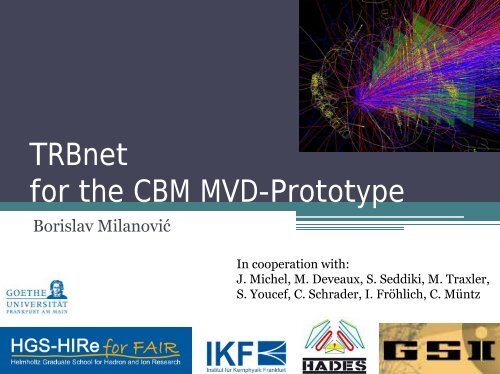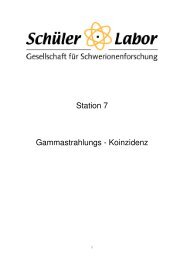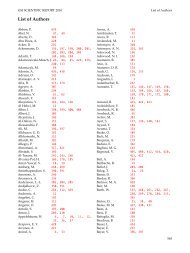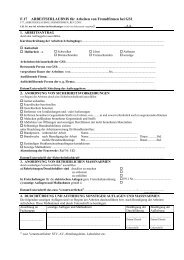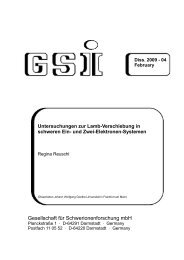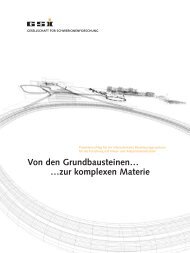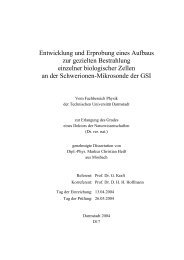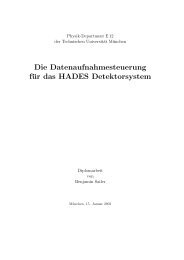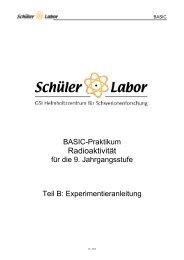TRBnet for CBM - GSI
TRBnet for CBM - GSI
TRBnet for CBM - GSI
Create successful ePaper yourself
Turn your PDF publications into a flip-book with our unique Google optimized e-Paper software.
<strong>TRBnet</strong><br />
<strong>for</strong> the <strong>CBM</strong> MVD-Prototype<br />
Borislav Milanović<br />
In cooperation with:<br />
J. Michel, M. Deveaux, S. Seddiki, M. Traxler,<br />
S. Youcef, C. Schrader, I. Fröhlich, C. Müntz
Overview 1/22<br />
Overview
<strong>TRBnet</strong>@HADES 2/22
<strong>TRBnet</strong>@HADES – Specifications 3/22<br />
HADES Specifications<br />
• 80 000 data channels<br />
• 520 PCBs / 550 FPGAs<br />
• 6 Detector Systems<br />
• Au Au:<br />
20 kHz trigger rate (10 5 collision rate)<br />
200 particles/event<br />
200 MByte/s
<strong>TRBnet</strong>@HADES – Explanation 4/22<br />
<strong>TRBnet</strong> ?<br />
• Protocol<br />
HADES and FAIR<br />
DAQ<br />
FPGA + Optical Links<br />
• Network<br />
Unified Bus<br />
Secure Transmission
<strong>TRBnet</strong>@HADES – Network 5/22<br />
372 x<br />
30 x<br />
6x<br />
9 x<br />
24 x<br />
4 x<br />
12 x<br />
3 x<br />
2 x<br />
2 x<br />
20 × 2 GBit/s<br />
- Jan Michel, „Status of the HADES Upgrade“ -
<strong>TRBnet</strong> Key Features 6/22
<strong>TRBnet</strong> Key Features – Architecture 7/22<br />
Architecture<br />
Detector 1<br />
Detector 2<br />
Slow Control<br />
...<br />
Detector n<br />
Optical Network<br />
Data<br />
Processing<br />
Trigger<br />
System
<strong>TRBnet</strong> Key Features – Dataflow 8/22<br />
Dataflow<br />
Detector 1<br />
Detector 2<br />
Slow Control<br />
...<br />
Detector n<br />
Optical Network<br />
Data<br />
Processing<br />
Trigger<br />
System<br />
Max. 3 µs latency
<strong>TRBnet</strong> Key Features – Specifications 9/22<br />
<strong>TRBnet</strong> Specifications<br />
• Layers<br />
• Unique IDs<br />
• CRC checksum<br />
CRC<br />
• Four prioritized virtual<br />
Channels<br />
addr1 addr2 addr3<br />
5x 16bit
<strong>TRBnet</strong> Key Features – Channels 10/22<br />
<strong>TRBnet</strong> Specifications<br />
• Channel switching after each data packet<br />
1 Optical Link
<strong>TRBnet</strong> Key Features – Facts 11/22<br />
<strong>TRBnet</strong> Facts<br />
• 80 bit/packet, 64 bit payload<br />
Overhead 16 bit!<br />
• Error detection<br />
No inconsistent data through transport<br />
• Secure Transfers<br />
All boards answer each transfer<br />
• Independent on underlying System/Data<br />
• <strong>TRBnet</strong> reduces net-bandwidth to 63%<br />
E.g. Optical Link 3 Gbit/s 2 Gbit/s
MVD Requirements 12/22
MVD Requirements – Geometry 13/22<br />
MVD<br />
MAPS
MVD Requirements – Station 1 simulation 14/22<br />
Station 1 Simulation<br />
• Au Au @ 25GeV<br />
• 5•10 5 collision rate<br />
• T int = 10 µs<br />
• approx. 7 GByte/s<br />
- Sélim Seddiki, „MVD DAQ Prototype“ -<br />
Data Rate per Sensor [MByte/s]<br />
1 prototype
MVD Requirements – Prototype 15/22<br />
MVD Prototype<br />
MimoSIS-1<br />
• M26 high-res. inspired<br />
• 3 cm 2<br />
× 5<br />
MVD Module:<br />
• 2-sided, 0,37 between sensors: 2 x 50 µm Si, 300 µm CVD-Diam., 2 x 35<br />
µm Glue → 350 µm Si equ , (0.37 % X0), Ø 359 µm Si equ , (0.383 % X0)<br />
• 5 sensors / module<br />
• 500 µm overlap of opposite sensors (pitch: ~ 20 µm)<br />
•9 cm 2<br />
=<br />
=<br />
× 4<br />
- Christian Müntz -
MVD Requirements – Datarate 16/22<br />
Comparison<br />
Trigger<br />
Particles<br />
Datarate<br />
• Main challenge:<br />
40 Gbit/s<br />
Self-Triggering<br />
HADES MVD<br />
20 kHz Nonstop<br />
200 1600<br />
200 MB/s 5GB/s (Prototype)
Evaluation and Future Actions 17/22
Evaluation and Future Actions – Readout 18/22<br />
Scheme<br />
40 Gbit/s<br />
FPG<br />
A<br />
...<br />
FPG<br />
A<br />
MVD-Prototype <strong>TRBnet</strong><br />
2 Gbit/s effective*<br />
... ...<br />
=> 25 optical links<br />
*Bandwidth depends on<br />
the FPGA frequency<br />
<strong>TRBnet</strong><br />
HUB
Evaluation and Future Actions – Readout 19/22<br />
Scheme<br />
8b10b + twisted pair copper<br />
MVD-Prototype<br />
40 Gbit/s<br />
FPG<br />
ROC A<br />
...<br />
FPG<br />
A<br />
<strong>TRBnet</strong><br />
2 Gbit/s effective*<br />
... ...<br />
=> 25 optical links<br />
*Bandwidth depends on<br />
the FPGA frequency<br />
<strong>TRBnet</strong><br />
HUB
Evaluation and Future Actions – First steps 20/22<br />
First Steps<br />
• MAPS Addon Board with PEXOR Card<br />
First <strong>TRBnet</strong> implementation <strong>for</strong> MAPS<br />
• <strong>TRBnet</strong> Hubs<br />
Datarate simulation<br />
1 MAPS PC<br />
data
Evaluation and Future Actions – Summary 21/22<br />
Summary<br />
• <strong>TRBnet</strong> is ideally suited <strong>for</strong> the first MVD<br />
prototype simulations<br />
▫ Already implemented<br />
▫ Highly modular (written in VHDL)<br />
▫ Various configurations<br />
▫ Low latency (3 µs), decent bandwidth (63 %)<br />
▫ Extensible - new designs, larger data buffers<br />
• Tested on XILINX and Lattice FPGAs @ HADES<br />
▫ up to 100 MHz, 16bit data <strong>for</strong>mat<br />
• First steps towards the ROC
References 22/22<br />
References<br />
• J. Michel, „Development of a Realtime Network Protocol <strong>for</strong> HADES<br />
and FAIR Experiments“<br />
• J. Michel, „Status of the HADES Upgrade“<br />
• I. Fröhlich, „The Readout of the <strong>CBM</strong> MVD“<br />
• M. Deveaux, „Status of the Micro Vertex Detector of the <strong>CBM</strong><br />
Experiment“<br />
• S. Seddiki, „MVD DAQ Prototype“


